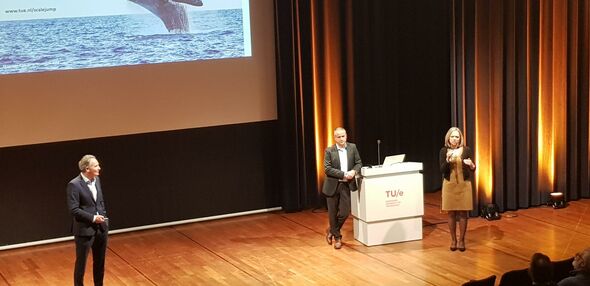
- The University
- 18/11/2022
Executive Board answers questions about upscaling
During a Dutch and English-spoken Q&A session in a packed Blauwe Zaal yesterday, TU/e’s Executive Board, assisted by physics dean Kees Storm, tried to answer a wide variety of questions about the university’s upscaling plans. The board didn’t have a concrete answer to every question. President Robert-Jan Smits did however make one thing very clear: if the cabinet doesn’t make additional means available in its upcoming Spring Memorandum, all upscaling plans will be pushed aside.
On Monday, it was announced that the cabinet and the Brainport region plan to make a €1.6 billion joint investment in projects that need to make Eindhoven and its surrounding municipalities more accessible. It made Executive Board president Robert-Jan Smits very content. He did however say yesterday that he hoped that this was just a first step towards a second announcement in the spring of 2023 that the cabinet will also make additional funding available for TU/e’s upscaling plans. “No money, no party,” he warned. Incidentally, no amounts were specified during yesterday’s Q&A session in the Blauwe Zaal.
Growth master’s programs
Professor Kees Storm, dean of the department of Applied Physics and Science Education since September and a member of the upscaling core team, took some time to explain what this upscaling entails. The university hopes to realize growth mainly through an increase in intake numbers for its master’s programs. “The shortest possible route to a diploma,” Storm said. The bachelor’s programs on the other hand are expected to remain stable at their current levels until 2035, with an annual intake number of just over two thousand first-year students. Intake of international students will be just as important for these programs as they are for the master’s programs, Storm believes, “but we need to make an effort to increase intake numbers for Dutch prospective students for our bachelor’s programs too.”
Intake numbers for the master’s programs will only start to show a serious increase around 2027, hopefully resulting in a doubling of the number of graduates compared to today’s numbers, the physics dean said. “We will use those first years to prepare ourselves for that extra intake.” And that will require quite a lot, including extra buildings on campus and a significant increase in the number of scientific and support staff members by 76 percent, according to Storm.
Where will we find all those extra staff members, one audience member wanted to know. Storm said that this isn’t just a task for those who are responsible for the university’s recruitment activities, but that talent will also attract talent. “We need to stop being modest and show the world all the great things we do here, as well as the opportunities there are in becoming a part of those things. It’s true that people can make more working in industry, but money shouldn’t be the only reason why people want to work here.”
Continue reading below the photo.
Partnership with industry
The university also needs to start focusing on domains that are of relevance to companies in the Brainport region. “That means that we might need to initiate new master’s programs, or develop new tracks.” Won’t the university hand over too much autonomy to industry, someone wanted to know. It certainly won’t be a matter of ‘you demand, we produce,’ Storm said, “because that’s not what industry wants at all. We at TU/e need to look ahead and think about what the world needs twenty years from now. Perhaps industry hasn’t even come up with an answer to that question at this point. That’s the only way for us to stay relevant in this region.”
Shouldn’t industry also contribute financially to realize TU/e’s upscaling ambitions? Executive Board president Smits says that it is already doing so, for example with hybrid teachers (people from industry who teach at TU/e one day a week, ed.) and internships, “but the topic of a financial contribution is also being discussed at this point.” No companies were mentioned by name, nor did Smits provide any further explanation about the exact nature of that contribution.
Boring Eindhoven
It’s also important that all those master’s students continue to work in the Brainport region after they graduate. Smits made it clear once more that many of them do so already. “No less than 85 percent of Dutch and 52 percent of international graduates work in the region.” A recently graduated master’s student said that he had just moved to Tilburg, because he found that city much more attractive than Eindhoven. “Eindhoven is boring, it has nothing to offer culturally for people my age. Many people around me have told me that they too want to leave the city as soon as they can. How do we make Eindhoven an interesting city?”
Smits said that he was surprised. After all, he left Brussels for Eindhoven in 2019 “because this city and region are vibrant and full of life. This is where important things will take place over the next few years. It’s not without reason that we were recognized as the country’s third main port in 2016. People who come to study here are practically guaranteed of a job.” He did however acknowledge the fact that Eindhoven lags behind cities in the Randstad region when it comes to investments in culture and sports facilities. “That’s what we and the city are seriously devoted to, ensuring that those investments will increase.”
Largest bottleneck
People in the audience also asked questions about the realization of new buildings on campus. When will it happen, and is there enough space? Vice-president Nicole Ummelen said that a rough sketch is currently in the making of three new buildings, “but that’s all quite premature.” Equally premature is the offer extended by the High Tech Campus and Automatic Campus in Helmond to come and take a look to see whether TU/e might expand at their locations. “We’re looking into that too,” Ummelen said.
Needless to say, the biggest problem was addressed as well. Realizing an increase in the number of students and staff members is a big enough challenge, but where will they all live? Ummelen, naturally, pointed out that the construction of two residential towers kicked off last Tuesday. But she immediately added that these towers are just a fraction of the solution to the housing problem. She said that the university is in the process of holding constructive talks about this issue with the city of Eindhoven and surrounding municipalities. “I know that we have people working at TU/e who live in Roermond, and compared to other countries, that’s not such a large distance. But we also know that students and staff members would like to live in Eindhoven. We need to promote the progression in the housing market. In the current situation, students continue to live in student homes after they graduate because they can’t find a new place to live, which makes it impossible for new students to find a room. We already had to say no to several hundreds of internationals because they were unable to find accommodation. It’s fair to say that this is the biggest bottleneck.”
People also asked questions about the sustainability aspect of the university’s upscaling plans, about whether growth in itself isn’t a thing of the past, and about the general impact of growth on study associations and the TU/e community in general. For now, however, the university awaits next year’s Spring Memorandum. Because if the cabinet won’t make any additional funding available, TU/e will continue to have a maximum capacity of 14,000 to 15,000 students.

Discussion